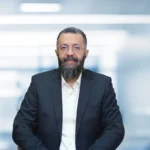The Unconventional Path of Kelp Blue’s Founder
Daniel Hooft’s Kelp Blue innovatively cultivates giant kelp for carbon sequestration, agricultural
BY Ben Alan
biostimulants, and coastal community empowerment, integrating environmental and societal benefits to address climate challenges.
CEO Daniel Hooft, with over 20 years in offshore engineering at Royal Dutch Shell across seven countries, speaks eight languages. Born in the Netherlands, raised in Dubai and Canada, Daniel’s path to founding Kelp Blue in 2020 has been anything but linear. This varied background has been key to his success as an entrepreneurial CEO.
A Sculptor Turned
Engineer
After leaving school, Daniel traveled throughout the former USSR, sculpting along the way. He returned to the Netherlands to study engineering at Delft University, maintaining his passion for sculpting. His drive to expand his horizons led him to the oil drilling industry, where he spent 20 years with Shell before establishing Kelp Blue.
The BIrth of Kelp Blue
The catalyst for Kelp Blue’s mission came from a chance encounter with climate change advocate Professor Tim Flannery. Flannery’s insights, relayed by Daniel’s wife after attending his talk, highlighted the urgent need to not only reduce emissions but also extract pollutants from the atmosphere and oceans. Flannery championed seaweed as a potent biological solution. Intrigued by this ‘impossible’ idea, Daniel delved deeper and discovered that while all parts of the value chain had been explored separately, no one had integrated them. Thus, Kelp Blue was born, reflecting Daniel’s commitment to addressing climate challenges through innovative solutions.
Kelp Blue’s PotentIal and Impact
Kelp Blue cultivates giant kelp on large-scale, offshore structures. Giant kelp, known for its rapid growth, forms dense forests that support marine life by offering food, shelter, and nursery grounds. During its growth, kelp stores carbon in its tissue, a portion of which is sequestered in the deeper ocean for long timescales. This process helps buffer ocean acidification locally while filtering surrounding waters.
The company’s innovative submerged structures allow kelp to form forests that are harvested and processed into a biostimulant called StimBlue+. This liquid kelp extract enhances crop resilience against climate-induced extremes like droughts, salinity, and heat, mimicking natural plant processes to boost growth, resistance, and yield. StimBlue+ contributes to local food security by reducing the need for synthetic fertilizers.
For coastal communities, kelp cultivation creates green, stable job opportunities, diversifies income sources, and drives the reskilling of individuals in areas affected by climate change and declining fish stocks. Kelp Blue’s holistic approach integrates environmental stewardship, community empowerment, and societal well-being through sustainable kelp farming.
Environmental and
Societal Benefits
Kelp Blue aims to sequester around 3 tonnes of CO2 per hectare per year, with a target farm size of 4,800 hectares by 2030, potentially sequestering 40,000 tonnes of CO2 annually. The biostimulant reduces the demand for synthetic fertilizers, improves agricultural soil health, and provides low-impact alternatives in the plastics and leather industries. The company performs Life Cycle Assessments (LCA) to ensure its low environmental impact.
Kelp Blue is also developing the methodology to quantify carbon sequestration through kelp in collaboration with the Kelp Forest Foundation, Gold Standard, and Carbonomics. This effort positions kelp as a viable blue carbon method, although accurate measurement remains a work in progress.
The Global PotentIal of Kelp Farming
Currently, over 98% of seaweed cultivation occurs in Asia on a small scale. Kelp Blue’s method is unique, featuring the cultivation of giant kelp, a perennial species that doesn’t require annual replanting. The company uses offshore technology for large-scale deployment, creating forest-like structures that support marine ecosystems and long-term carbon sequestration. Their innovative harvesting method involves trimming the canopy with a solar-powered, unmanned ocean harvester, and the no-waste approach in biorefinery processing ensures sustainability.
Restorng Ecosystems and Community Empowerment
Kelp forests play a crucial role in replenishing and rewilding overfished coastal areas, providing habitat and food for numerous species. The oceans absorb most excess CO2, causing acidification that harms marine life. Giant kelp helps mitigate this by capturing carbon through photosynthesis, oxygenating, and de-acidifying surrounding waters. The organic carbon from kelp is cycled to deeper ocean layers, contributing to long-term carbon sequestration.
Kelp Blue’s commitment extends to building resilient communities through skilled employment opportunities and education. Their Lüderitz Blue School, offering the British National Curriculum with a focus on ocean awareness, aims to inspire young minds and provide ocean-focused after-school activities. High scholarship proportions ensure broad access to quality education.
RecognItIon and Future Prospects
Kelp Blue’s innovative approach has earned it a spot as an XPRIZE finalist in the $100M carbon removal incentive competition backed by Elon Musk and the Musk Foundation. This recognition underscores the potential of kelp farming to significantly impact global carbon sequestration efforts and highlights Daniel Hooft’s vision and dedication to creating a more sustainable future.






























